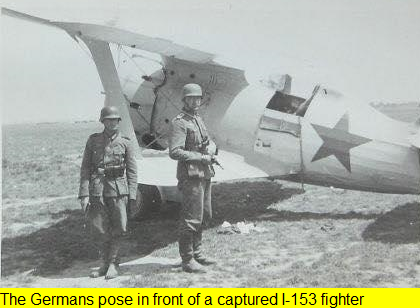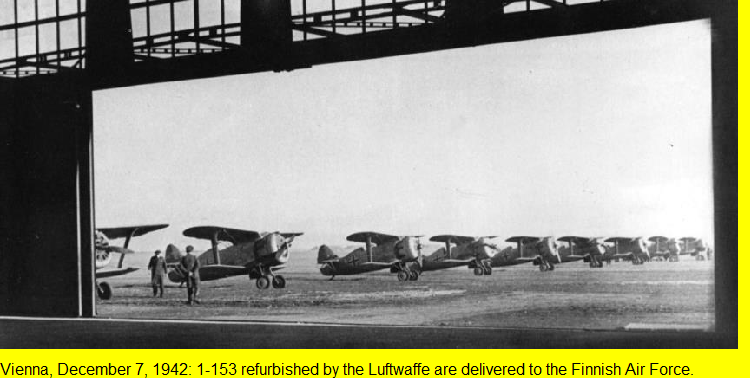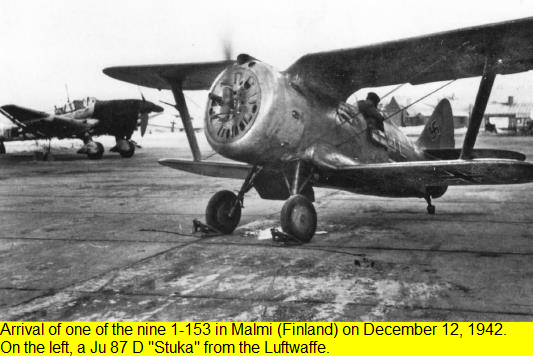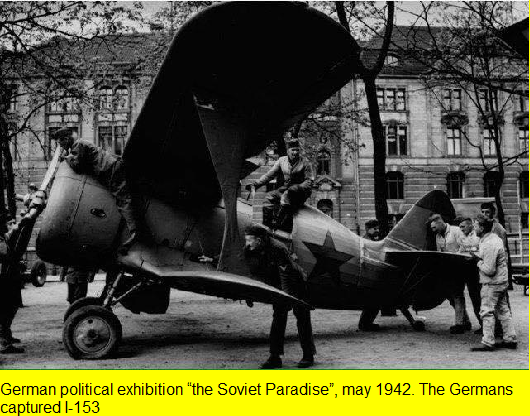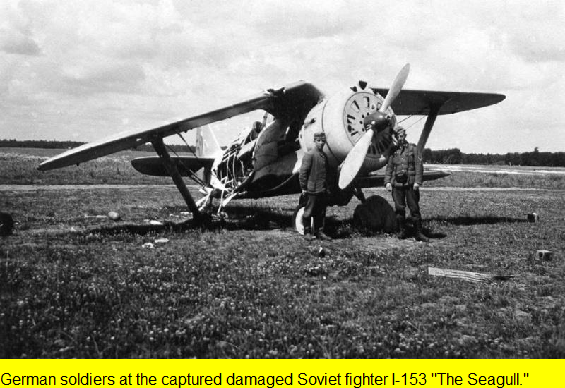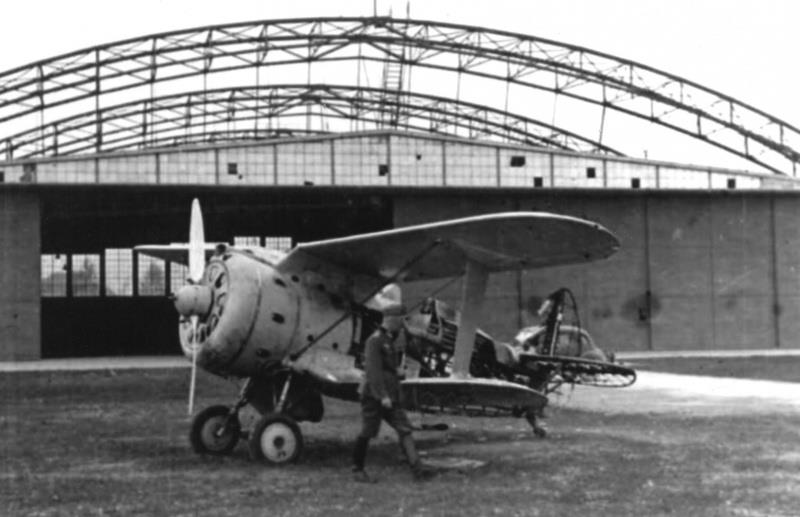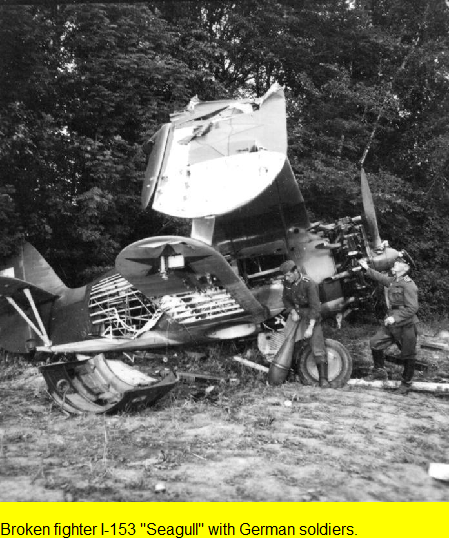In 1937, the Polikarpov design bureau carried out studies to improve on the performance of its I-15 and I-15bis biplane fighters without sacrificing manoeuvrability, as Soviet tactical doctrine was based on a mix of high performance monoplane fighters (met by the Polikarpov I-16) and agile biplanes. Early combat experience from the Spanish Civil War had shown that the I-16 had problems dealing with the Fiat CR.32 biplanes used by the Italian forces supporting the Nationalists, which suggested a need to continue the use of biplane fighters, and as a result, Polikarpov's proposals were accepted, and his design bureau was instructed to design a new biplane fighter. Polikarpov assigned the task to the design team led by Aleksei Ya Shcherbakov, who was assisted by Artem Mikoyan and Mikhail Gurevich (who would later set up the MiG design bureau).
The new fighter (designated I-15ter by the design bureau and I-153 by the Soviet Air Forces (VVS) was based closely on the design of the I-15bis, with a stronger structure, but was fitted with a manually retractable undercarriage to reduce drag. It reverted to the "gulled" upper wing of the original I-15 but used the Clark YH aerofoil of the I-15bis. The four 7.62 mm PV-1 machine guns of the I-15bis were replaced by four ShKAS machine guns. While still rifle-calibre weapons, these fired much faster than the PV-1s, (1,800 rounds per minute rather than 750 rounds per minute giving a much greater weight of fire. The new fighter was to be powered by a Shvetsov M-62 an improved derivative of the Shvetsov M-25 that powered the I-15 and I-15bis with twin superchargers.
The aircraft was of mixed metal and wood construction, with the fuselage structure being based on chromium-molybdenum steel with duralumin skinning on the forward fuselage, and fabric covering on the fuselage aft of the front of the cockpit. The aircraft's wings were made of fabric covered wood, while the tail surfaces were of fabric covered duralumin. The aircraft was fitted with a tailwheel undercarriage, with the mainwheels retracting rearwards, rotating through 90 degrees to lie flat in the wing roots, being actuated by cables operated by a pilot-driven handwheel. The solid rubber tailwheel did not retract, but moved in conjunction with the rudder.
The M-62 was not ready by the time the first prototype was complete, so it was fitted with a 750 hp (560 kW) M-25V engine when it made its maiden flight in August 1938. The first prototype failed factory testing due to numerous defects, but this did not stop production, with the aircraft entering production concurrently with ongoing testing and development. Early production I-153s powered by the M25 engine passed state testing during 1939, despite the loss of one aircraft which disintegrated in a 500 km/h dive. In test flights, the I-153 (M-25) achieved the top speed of 424 km/h , service ceiling of 8,700 m , and required 6 minutes 24 seconds to reach 5,000 m . This performance was well in excess of that demonstrated by the I-15bis.
During 1939, production switched to a version powered by the originally planned M-62 engine, with an M-62 powered prototype undergoing state testing from 16 June 1939. While speed at sea level was virtually unchanged, the new engine improved performance at altitude. A speed of 443 km/h at 4,600 m was recorded, with a service ceiling of 9,800 m . This performance was disappointing, and caused the aircraft to fail the state acceptance trials, although this did not disrupt production.[11] While it was recognised that the I-153's performance was inadequate, the over-riding requirement was to not disrupt production until more advanced fighters could enter production.
While numerous improvements were proposed, many were too radical to be implemented since the aircraft was already in production. Desperate to improve performance, Polikarpov tested two I-153 with the Shvetsov M-63 engine with 820 kW (1,100 hp). However, the results were disappointing and it was becoming painfully obvious that the biplane airframe was incapable of higher speeds.
One of the rarely mentioned characteristics of the I-153 was its poor performance in a spin. While the Polikarpov I-16 had gained notoriety for entering spins, pilots found it easy to recover from a spin. In contrast, while the I-153 was difficult to spin, once it lost control, recovery was difficult to the point where intentional spinning was forbidden for some time. A spin recovery procedure was eventually developed but, while effective, it required flawless timing and execution.
By the end of production in 1941, a total of 3,437 I-153s were built.
The I-153 first saw combat in 1939 during the Soviet-Japanese Battle of Khalkin Gol in Mongolia. The Japanese Army Air Forces' Type 97 Fighter (Nakajima Ki-27) Nate proved a formidable opponent for the I-15bis and I-16, but was more evenly matched with the I-153, which retained agility inherent to biplanes while featuring improved performance. While the overall I-153 performance was satisfactory, some significant problems were revealed. Most troublesome was the absence of a firewall between the fuel tank mounted in front of the cockpit and the pilot. Combined with strong draft coming in through the wheel wells, fuel tank fires invariably resulted in rapid engulfment of the cockpit and severe burns to the pilot. In addition, the M-62 engine suffered from a service life of only 60-80 hours due to failures of the two-speed supercharger.
The Polikarpov I-153 Chaika never flew with any Spanish Air Force units during or after the Spanish Civil War. Two earlier variants of this aircraft, the I-15 and the I-15bis, did fly with the Republican Air Force during the conflict and, later, captured examples of both types were used by the Fuerzas Aéreas till the early 1950s.
| Type |
Single seat fighter |
| Engine |
1 Shvetsov M-62 with a 2-bladed variable pitch propeller |
| Dimensions |
Length 6,18 m , height 4,6 m , span upper 10,0 m lower 7,5 m, wing area 22,1 m2 , |
| Weights |
Empty 1452 kg, loaded , max. take off weight 2110 kg |
| Performance |
Max.. speed 444 km/h at 4600 m , cruising speed 297 km/h at 2000 m , range 470 km, endurance , service ceiling 10700 m , climb 15 m/sec., to 7000 m 8 min. 18 sec. |
| Armament |
4 7.62 mm ShKAS machine guns, 2,600 rounds of 7.62×54mm ammunition, Rockets: 8 x 82 mm RS-82 rockets |
| Type |
Werk.Nr |
Registration |
History |
|
7068 |
|
Stab/Luftiandegeschwader 1, is100% destroyed on July 30, 1942 after having broken his landing gear on the field of Hildesheim. |
|
8252 |
H4+MB, IT-31 |
Stab/Luftiandegeschwader 1. Delivered to Finland on August 27, 1943. |
|
6454 |
IT-22 |
Delivered to Finland between December 29 1942 to 8 January 1943 |
|
6514 |
IT-23 |
Delivered to Finland between December 29 1942 to 8 January 1943 |
|
6627 |
IT-24 |
Damaged , nose in a ditch at Olmütz. Repaired, delivered to Finland April 13, 1943 |
|
7046 |
IT-25 |
Delivered to Finland between December 29 1942 to 8 January 1943 |
|
7058 |
IT-26 |
Delivered to Finland between December 29 1942 to 8 January 1943 |
|
7141 |
IT-27 |
Delivered to Finland between December 29 1942 to 8 January 1943 |
|
8161 |
IT-28 |
Delivered to Finland between December 29 1942 to 8 January 1943 |
|
8232 |
IT-29 |
Delivered to Finland between December 29 1942 to 8 January 1943 |
|
8245 |
IT-30 |
Delivered to Finland between December 29 1942 to 8 January 1943 |


